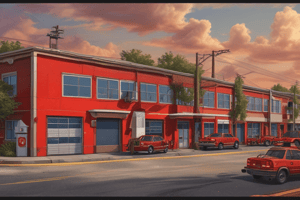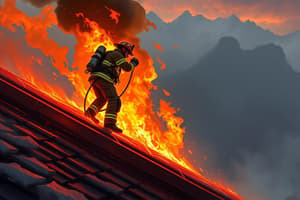Podcast
Questions and Answers
Which factor most critically determines the strategic positioning of aerial devices during firefighting operations?
Which factor most critically determines the strategic positioning of aerial devices during firefighting operations?
- Allowing for rapid deployment of firefighters directly onto the fire floor.
- Minimizing visibility from the street to reduce public alarm.
- Ensuring the quickest possible access to initiate interior attack.
- Facilitating safe access to and egress from the roof, while also permitting effective defensive operations. (correct)
Besides the Incident Commander, which role is specifically tasked with observing roof conditions during firefighting operations to maintain safety and awareness?
Besides the Incident Commander, which role is specifically tasked with observing roof conditions during firefighting operations to maintain safety and awareness?
- The Rapid Intervention Team (RIT) supervisor.
- The Company Officer of the first arriving engine.
- The interior attack team leader.
- The Assistant Safety Officer. (correct)
What combination of resources and equipment must a company assigned to roof operations have before accessing the roof?
What combination of resources and equipment must a company assigned to roof operations have before accessing the roof?
- Full PPE, SCBA, radio, roof ladder, and tools for sounding the roof, accessed via a minimum of two means of egress from an established stable platform. (correct)
- Full PPE, SCBA, radio, roof ladder, and tools for forcible entry, accessed via a minimum of one means of egress from a stable platform.
- Partial PPE, SCBA, radio, roof ladder, and tools for overhaul, accessed via a minimum of two means of egress from an established stable platform.
- Full PPE, SCBA, radio, roof ladder, and tools for sounding the roof, accessed via a minimum of two means of egress from an unstable platform.
Which of the following DOES NOT constitute a stable platform for accessing a roof during firefighting operations?
Which of the following DOES NOT constitute a stable platform for accessing a roof during firefighting operations?
During roof operations, how does an 'area of safe refuge' contribute to the overall safety strategy?
During roof operations, how does an 'area of safe refuge' contribute to the overall safety strategy?
Which element is LEAST critical to include in a thorough roof report provided to the Incident Commander?
Which element is LEAST critical to include in a thorough roof report provided to the Incident Commander?
Why is it vital to place a vertical ventilation hole as close to or directly over the fire as possible?
Why is it vital to place a vertical ventilation hole as close to or directly over the fire as possible?
What is the PRIMARY purpose of utilizing a brush fire flat hose equipped with a garden style nozzle set to a rain droplet setting for gross decon?
What is the PRIMARY purpose of utilizing a brush fire flat hose equipped with a garden style nozzle set to a rain droplet setting for gross decon?
In the event of establishing a fire watch, which entity should be notified immediately via email?
In the event of establishing a fire watch, which entity should be notified immediately via email?
Which of the following scenarios accurately describes a Mass Casualty Incident (MCI) as defined in the provided guidelines?
Which of the following scenarios accurately describes a Mass Casualty Incident (MCI) as defined in the provided guidelines?
At which MCI level would you anticipate encountering a patient count that falls within the range of 21 to 100 individuals?
At which MCI level would you anticipate encountering a patient count that falls within the range of 21 to 100 individuals?
During a large-scale chemical spill resulting in numerous casualties, which external agency might the FOO contact for additional support beyond Palm Beach County resources?
During a large-scale chemical spill resulting in numerous casualties, which external agency might the FOO contact for additional support beyond Palm Beach County resources?
Which resource from the FOO's maintained list would be MOST beneficial for providing care and support to approximately 200 patients during a large-scale incident?
Which resource from the FOO's maintained list would be MOST beneficial for providing care and support to approximately 200 patients during a large-scale incident?
Why is it crucial to leave the original triage ribbon in place during secondary assessment of patients in an MCI?
Why is it crucial to leave the original triage ribbon in place during secondary assessment of patients in an MCI?
What specific information, beyond the patient's name and demographics, is essential to include in the transport log during an MCI?
What specific information, beyond the patient's name and demographics, is essential to include in the transport log during an MCI?
For which of the following MCI levels is a formal After Action Review (AAR) mandated to assess response effectiveness and identify areas for improvement?
For which of the following MCI levels is a formal After Action Review (AAR) mandated to assess response effectiveness and identify areas for improvement?
In a suspected case of physical abuse, what immediate steps MUST fire rescue personnel take while on scene?
In a suspected case of physical abuse, what immediate steps MUST fire rescue personnel take while on scene?
When faced with a mentally competent patient refusing transport, what is the MOST critical action fire rescue personnel should undertake before leaving the scene?
When faced with a mentally competent patient refusing transport, what is the MOST critical action fire rescue personnel should undertake before leaving the scene?
Why is it crucial for the decon drop zone to be located remotely and downwind of the rehabilitation area?
Why is it crucial for the decon drop zone to be located remotely and downwind of the rehabilitation area?
When dealing with a confirmed structure fire in a rural area with limited water supply, which water supply tactic is MOST advisable for the initial response?
When dealing with a confirmed structure fire in a rural area with limited water supply, which water supply tactic is MOST advisable for the initial response?
Under what circumstances is the utilization of Folding/Dump Tank Operations indicated as the MOST suitable method for water supply?
Under what circumstances is the utilization of Folding/Dump Tank Operations indicated as the MOST suitable method for water supply?
What is the PRIMARY reason for implementing a fire watch, and who typically makes the decision to establish one?
What is the PRIMARY reason for implementing a fire watch, and who typically makes the decision to establish one?
In non-wildland fire scenarios, under what specific circumstance would a fire watch need to be immediately established by the building owner or their assign?
In non-wildland fire scenarios, under what specific circumstance would a fire watch need to be immediately established by the building owner or their assign?
Why is it essential to avoid embedding toxins further into the fabric during the decon process after a fire?
Why is it essential to avoid embedding toxins further into the fabric during the decon process after a fire?
Considering the average water requirements for extinguishing a room and contents fire in a typical single-family dwelling, what conditions would necessitate the HIGHEST end of the typical water volume range?
Considering the average water requirements for extinguishing a room and contents fire in a typical single-family dwelling, what conditions would necessitate the HIGHEST end of the typical water volume range?
When initiating relay pumping operations in rural firefighting scenarios, what is the MOST critical factor to consider when positioning the pumper at the water source?
When initiating relay pumping operations in rural firefighting scenarios, what is the MOST critical factor to consider when positioning the pumper at the water source?
During 'Float a Pump' operations, why is it crucial to position the source pumper as close as possible to the pumps being floated?
During 'Float a Pump' operations, why is it crucial to position the source pumper as close as possible to the pumps being floated?
In the context of rural firefighting, describe a circumstance that would necessitate immediate notification of the Fire Marshal.
In the context of rural firefighting, describe a circumstance that would necessitate immediate notification of the Fire Marshal.
Flashcards
Aerial Positioning
Aerial Positioning
Strategic placement for safe roof access/egress and potential defensive operations.
Roof Observer
Roof Observer
Observe roof conditions during operations; typically assigned to the Assistant Safety Officer.
Roof Operations Team Requirements
Roof Operations Team Requirements
Access from stable platform, minimum 2 egresses, full PPE/SCBA/radio, roof ladder, sounding tools.
Stable Platform (Roof)
Stable Platform (Roof)
Signup and view all the flashcards
Area of Safe Refuge (Roof)
Area of Safe Refuge (Roof)
Signup and view all the flashcards
Roof Report Contents
Roof Report Contents
Signup and view all the flashcards
Roof Operations Objectives
Roof Operations Objectives
Signup and view all the flashcards
When to perform Gross Decon
When to perform Gross Decon
Signup and view all the flashcards
MCI definition
MCI definition
Signup and view all the flashcards
MCI Levels
MCI Levels
Signup and view all the flashcards
MCI types
MCI types
Signup and view all the flashcards
FOO Resource list
FOO Resource list
Signup and view all the flashcards
Secondary Assessment During MCI
Secondary Assessment During MCI
Signup and view all the flashcards
Transport Log (MCI)
Transport Log (MCI)
Signup and view all the flashcards
Formal After Action Review
Formal After Action Review
Signup and view all the flashcards
Suspected Physical Abuse
Suspected Physical Abuse
Signup and view all the flashcards
Suspected Sexual Abuse
Suspected Sexual Abuse
Signup and view all the flashcards
Florida Statute 401.445
Florida Statute 401.445
Signup and view all the flashcards
Why is flushing PPE important?
Why is flushing PPE important?
Signup and view all the flashcards
What is the Drop Zone?
What is the Drop Zone?
Signup and view all the flashcards
How is the Decon Bag sealed?
How is the Decon Bag sealed?
Signup and view all the flashcards
Who are 'Highly Exposed personnel'?
Who are 'Highly Exposed personnel'?
Signup and view all the flashcards
What does the Hydrant Navigation System do?
What does the Hydrant Navigation System do?
Signup and view all the flashcards
What is a Water Supply Officer (WSO)?
What is a Water Supply Officer (WSO)?
Signup and view all the flashcards
How wide is a standard 1 1/4 acre lot?
How wide is a standard 1 1/4 acre lot?
Signup and view all the flashcards
What are the 4 rural water supply means?
What are the 4 rural water supply means?
Signup and view all the flashcards
What is Modified Direct Pumping?
What is Modified Direct Pumping?
Signup and view all the flashcards
When is a fire watch needed (non-fire)?
When is a fire watch needed (non-fire)?
Signup and view all the flashcards
Study Notes
- Aerials should allow safe roof access/egress and tactical positioning for defensive operations.
- An Assistant Safety Officer or assigned individual observes roof conditions during operations.
- Roof operation companies: access roofs from stable platforms, have ≥2 egresses, full PPE/SCBA/radio, roof ladder, and sounding tools.
- Stable platforms include safety lines, roof ladders, and aerial devices.
- A structurally sound, unexposed roof area acts as a safe refuge/egress.
- Roof reports detail design/construction, structural/fire conditions, firewalls, openings, heavy objects, and ventilation plans.
- Roof operation objectives: constant structural stability evaluation, adequate vertical ventilation, and progress reports to the IC.
- Ventilation roof cuts: 7-9-8 for flat roofs; bay/louver for pitched roofs (if safe).
- Vertical ventilation holes must be 16 sq ft (4x4) and near/over the fire.
- Use kerf (plunge) cuts and triangular inspection holes to check for fire on roofs.
- All PPE exposed to combustion products requires Gross Decon.
- All personnel exposed to combustion products do Gross Decon before rehab, leaving the incident, or training.
- Gross Decon is located in the Warm Zone.
- First-arriving suppression establishes/oversees Gross Decon near combustion products.
- Drivers ensure clean municipal water (hydrant) and designated area with decon hose/green cone.
- Decon uses a brush fire flat hose with a garden-style nozzle (rain droplet setting) for high-flow, low-pressure flushing.
- The PPE drop zone is in the Warm Zone, downwind/remote from Rehab (off-gassing).
- Decon bags are twisted/taped, goose-necked, then twisted/taped again.
- "Shower within the hour" requires Battalion Chief approval, starts upon scene release.
- "Highly Exposed" are personnel performing interior tasks in thick smoke.
- Rural brush trucks have 800-1000ft of 3" hose, 200ft of 1 3/4" hose, and 2 SCBAs.
- The Hydrant Navigation System shows hydrant locations/flow rates, dry hydrants, and static water sources.
- All stations responding to structure fires in rural PBC send a brush truck with the engine (excluding 600 Series brush units).
- A Water Supply Officer (WSO) is well-versed in rural water supply.
- A standard 1 1/4 acre lot is ~200' wide for hose lay estimations in rural areas.
- Single-family dwellings need 250-500 gpm for room/contents fires.
- Single-family dwellings need 2,000-10,000 gallons of water for room/contents fires.
- Four rural water supply methods: Modified Direct Pumping, Nurse Tender, Relay Pumping, Folding/Dump Tank.
Water Supply Methods
- Modified Direct Pumping uses all on-scene water-carrying units to supplement the attack pumper.
- It involves 2 engines, 2 brush trucks, and 1 tender, yielding 6000 gallons.
- Modified Direct Pumping is used for short-duration fires (rooms, garages, sheds).
- It is recommended for confirmed rural structure fires with limited water.
- Nurse Tender Operations involve a tender supplying water directly to the attack engine.
- Nurse Tender Operations are recommended for short-duration fires.
- Nurse Tender Operations is unsuitable if the incident could expand.
- Relay Pumping Operations are preferred when water is unavailable near the fire.
- The pumper with the largest capacity is at the water source.
- 5" supply lines should be used from the water to the fire scene
- For long lays, lay the entire hose bed
- Folding/Dump Tank Operations are indirect water supplies using portable tanks.
- Dump tanks are for when the water source is far and relay is impractical.
- Tanks hold 3,000-5,000 gallons each.
- The supply engine drafts from the tank to relay to attack.
- Folding/Dump Tank Operations requires a minimum of 2 tenders.
- Cannot be used to supply master streams/aerials.
- Incidents needing 300+ gpm require multiple tanks.
- Tenders carry 3,000 gallons of water, foam, and SCBAs; back down the roadway.
- Float a Pump Operations are for inaccessible draft sites and a last resort.
- Float a Pump Operations requires ≥2 high-volume pumps.
- Place the source pump as close as possible to the pumps and monitor constantly.
- Fire watch is needed if potential for rekindle exists, the structure is unsafe, suppression and/or notification systems are non-functioning but the structure remains habitable.
- For wildland fires, establish a fire watch to extinguish potential rekindles/hot spots. Record conditions and actions.
- For non-fire situations, a fire watch is needed if the system is non operational OR upon notification/ discovery of a fire suppression system not being 100%
- The Fire Marshal determines actions, including fire watch, if an occupancy presents an immediate safety threat.
- For non-wildland fire watches, provide documents to the owner and notify the Fire Marshal's Office ([email protected]) immediately.
MCI Levels
- MCI is when the number of patients overwhelms first-arriving units.
- Level 1: 5-10 patients
- Level 2: 11-20 patients
- Level 3: 21-100 patients
- Level 4: 101-1,000 victims
- Level 5: Over 1,000 victims
- MCI types include shootings, explosions, collapses, plane crashes, vehicle accidents, chemical, biological, radiological, and nuclear events.
- The FOO may contact the State Warning Point for additional resources outside of PBC.
- The FOO maintains a resource list: Tactical Command Unit, Area Command Team, Incident Management Team, Support 81, Disaster Response Unit, Tactical 34, Inventory Specialist.
- Secondary patient assessment during MCI uses METAG and leaves the original triage ribbon to show changing status.
- Transport logs include the patient's METAG ID, destination hospital, and transport unit number.
- A formal After-Action Review is required for MCI Level 3 or greater.
Abuse
- A vulnerable adult is someone 18+ whose ability to care for themselves is impaired due to disabilities or aging.
- For suspected physical abuse: notify law enforcement and EMS Captain; do NOT leave the victim alone (transport or turnover to LE).
- Follow up activities where a patient was transported for suspected abuse. Report to Florida Abuse Hotline, initiate MIH, thoroughly document.
- Suspected sexual abuse procedure of a minor or vulnerable adult: Notify law enforcement, PBC Victims Services Rape Crisis to request SART, Florida Abuse Hotline, and EMS Captain.
- Documentation for abuse calls: identify/document any items moved/altered, items left by Fire Rescue, comments by the patient, complete MIH referral. Mentally competent patients have the right to refuse all or any portion of treatment or transport if they meet all of the following criteria AAOX4, Clinically Sober, and Without life threatening or potentially life threatening emergency conditions that could impair their judgement
- Conditions that could impair judgment: hypoxia
- When a patient refuses transport, use all efforts to have a competent adult stay with them and inform them to call 911 if their condition changes.
- Florida Statute 401.445 allows emergency treatment of incapacitated people without consent (but no unreasonable force).
Studying That Suits You
Use AI to generate personalized quizzes and flashcards to suit your learning preferences.
Description
Guidelines for safe roof access, tactical positioning, and ventilation during firefighting operations. Covers roof condition assessment, stable platforms, and emergency egress. Details roof reports, structural stability evaluation, ventilation techniques, and cutting methods.




